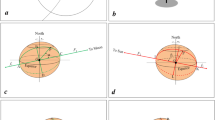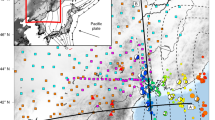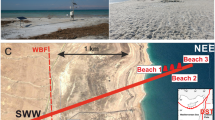Abstract
The Earth's gravitational field, and hence the shape of the Earth's sea-level surface, the geoid, can be determined from analysis of the motion of artificial satellites in orbit about the Earth. The method is particularly powerful in revealing the longitude-averaged meridional profile of the geoid, that is, an average slice through the poles, which from its north–south asymmetry is often called ‘pear-shaped’. We now report an improved determination of this profile, which should be accurate to about 50 cm at latitudes up to 86°, and replaces our previous evaluation1,2.
This is a preview of subscription content, access via your institution
Access options
Subscribe to this journal
Receive 51 print issues and online access
$199.00 per year
only $3.90 per issue
Buy this article
- Purchase on SpringerLink
- Instant access to full article PDF
Prices may be subject to local taxes which are calculated during checkout
Similar content being viewed by others
References
King-Hele, D. G. & Cook, G. E. Nature 246, 86 (1973).
King-Hele, D. G. & Cook, G. E. Planet. Space Sci. 22, 645 (1974).
Merson, R. H. & King-Hele, D. G. Nature 182, 640 (1958).
Brookes, C. J. & Holland, D. Planet. Space. Space Sci. 26, 611 (1978).
Brookes, C. J. Planet. Space Sci. 24, 711 (1976).
King-Hele, D. G., Brookes, C. J. & Cook, G. E. Geophys. J. R. astr. Soc. (in the press).
Lerch, F. J. et al. Paper Spring A. Meet. Am. Geophys. Un. Florida (1978).
Author information
Authors and Affiliations
Rights and permissions
About this article
Cite this article
King-Hele, D., Brookes, C. & Cook, G. The pear-shaped section of the Earth. Nature 286, 377–378 (1980). https://doi.org/10.1038/286377a0
Received:
Accepted:
Issue date:
DOI: https://doi.org/10.1038/286377a0



